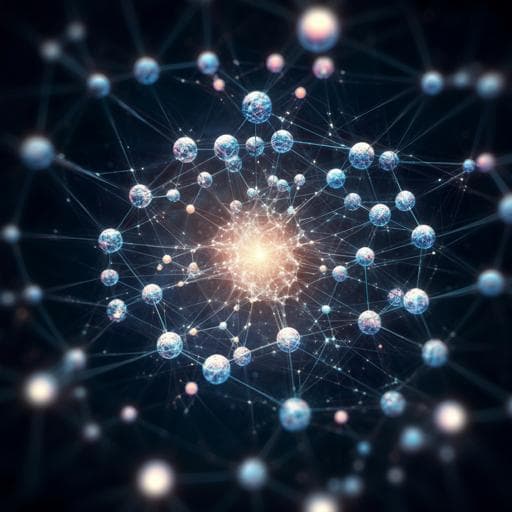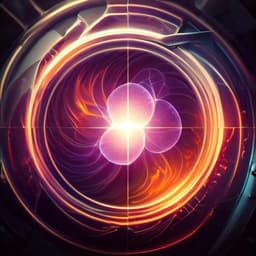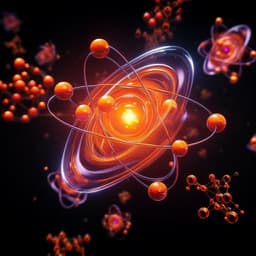
Physics
Quantum Computation and Quantum Simulation with Ultracold Molecules
S. L. Cornish, M. R. Tarbutt, et al.
Explore the mesmerizing world of ultracold molecules, which hold immense promise for advancing quantum information processing and simulation. Researchers Simon L. Cornish, Michael R. Tarbutt, and Kaden R. A. Hazzard delve into the breakthroughs and ongoing challenges in harnessing these fascinating entities to unlock their full potential.
~3 min • Beginner • English
Introduction
The paper reviews how ultracold polar molecules enable quantum simulation and quantum computation by exploiting their rich internal structure and controllable long-range dipole-dipole interactions. The research focus is to identify which molecular properties and control techniques best realize programmable spin models, entangling gates, and itinerant many-body physics, and to assess the state-of-the-art experimental capabilities and outstanding challenges. Contextually, ultracold molecules can be routinely prepared via atom association or direct laser cooling and confined in optical lattices or tweezers, enabling precise control of motional and internal states. The purpose is to synthesize theoretical and experimental advances, outline challenges (e.g., coherence limits, filling, and losses), and chart immediate next steps and emerging ideas to unlock the field’s potential. The study is significant because molecular platforms offer regimes of interaction strength, anisotropy, and internal-state resources distinct from atoms, opening avenues for simulating complex quantum matter and realizing scalable quantum information processing.
Literature Review
The authors situate the work within extensive prior literature on ultracold molecules, including early reviews on cooling, control, and applications (Carr et al. 2009; Bohn et al. 2017; Koch et al. 2019; Softley 2023). Foundational theory mapped rotational-state dipolar interactions to effective spin models (Barnett et al. 2006; Gorshkov et al. 2011), enabling XXZ, XY, Ising, and Heisenberg variants, and proposed advanced engineering via microwave dressing and Floquet techniques to realize symmetry-protected topological phases, spin-orbit coupling, and Kitaev models. For itinerant physics, extensions of t-J and Hubbard-type models with long-range dipolar interactions were proposed, predicting diverse ordered and superconducting phases. Experimental milestones include observing dipolar spin-exchange in KRb lattices, quantum Zeno suppression of losses, and recent quantum gas microscopy of NaRb demonstrating site-resolved correlations and Floquet-implemented XXZ models. Coherence control via magic conditions, polarization tuning, and dynamical decoupling has advanced, while tweezer-based platforms progressed from single-molecule arrays (CaF) to deterministic molecule assembly (NaCs, RbCs) with coherent control. Shielding strategies (DC, microwave, dimensional confinement) and recent demonstrations of evaporative cooling and quantum degeneracy (Fermi and Bose) addressed loss challenges, forming a foundation for current and future studies.
Methodology
As a review, the paper synthesizes theoretical frameworks and experimental methodologies across multiple groups. Theoretically, diatomic molecules are modeled as rigid rotors with rotational states |N, MN⟩ separated by the rotational constant B, with microwave-accessible transitions. Dipole-dipole interactions (DDI) between molecules are engineered via DC electric fields (inducing static dipoles), microwave dressing (creating oscillating dipoles), or by populating adjacent rotational states. Projecting the DDI onto chosen rotational manifolds maps to effective spin Hamiltonians (e.g., long-range XXZ with exchange J⊥ and Ising Jz terms tunable by field strength and geometry), with generalizations via microwave dressing and Floquet pulse sequences to realize tailored two-body interactions, anisotropy, and topological models. Itinerant models arise by allowing tunneling, yielding t-J-V-W Hamiltonians with long-range couplings; shielding modifies short-range physics to mitigate losses. Experimentally, two main architectures are detailed: (1) optical lattices for frozen-spin or itinerant simulations, including Ramsey spectroscopy of rotational coherences, quantum gas microscopy for site-resolved spin correlations, Floquet engineering via microwave sequences, and dynamical decoupling (e.g., XY8) to extend coherence; and (2) optical tweezer arrays for quantum computation, employing laser cooling and collisional blockade (CaF), or atom-by-atom assembly with Feshbach association and Raman transfer to ground-state molecules (NaCs, RbCs), followed by state preparation, motional ground-state cooling, and high-fidelity imaging. Methods to mitigate differential ac Stark shifts include polarization-angle tuning, intensity/ellipticity optimization, near-magic/magic wavelengths, and active magnetic-noise cancellation. Two-qubit entanglement protocols are reviewed: Ising-interaction-based gates with DC fields and frequency selectivity, spin-exchange gates using auxiliary rotational states, and stationary-state schemes using interaction-resolved transitions; robust control via optimized microwave pulses is discussed. Emerging hybrid methods use Rydberg atoms to mediate strong, resonant dipolar couplings for fast, high-fidelity molecular gates.
Key Findings
- Molecular advantages: abundant long-lived internal states (hyperfine/rotational), strong controllable DDI, high-fidelity state preparation and readout, and long coherence enabled by magic conditions and decoupling.
- Spin-model realization: Mapping DDI to long-range XXZ models with tunable J⊥ and Jz via state choice and electric-field strength/orientation; additional spin-density and density-density couplings below unit filling; itinerant extensions to t-J-V-W models.
- First spin-exchange observations: In 40K87Rb 3D lattices, Ramsey contrast oscillations at frequency matching nearest-neighbor J⊥/2ħ ≈ 52 Hz, with density-dependent decay characteristic of DDI; continuous quantum Zeno suppression of tunneling losses observed.
- Site-resolved correlations: 23Na87Rb quantum gas microscopy measured first-, second-, and third-neighbor spin correlations and anisotropy, and implemented Floquet engineering to realize an XXZ Hamiltonian from an initial XY (Jz=0) model.
- Tunable itinerant dynamics: 40K87Rb in 2D planes with DC+AC fields achieved control of x=J⊥−Jz; DDI-induced ~100 Hz transition shifts measured via Ramsey with XY8; interaction tunability via field strength and angle demonstrated; stronger DDI correlated with faster collisional decoherence.
- Coherence engineering: Near-magic lattices reduced differential polarizability to <1% yielding bare rotational coherence of 56(2) ms (NaRb). Second-scale rotational coherences reported for 87Rb133Cs by operating near weakly allowed transitions. XY8 dynamical decoupling improved coherence from 0.24(1) ms to 17(1) ms in itinerant settings.
- Tweezer-based milestones: CaF arrays with collisional blockade and high-fidelity imaging. NaCs molecule assembly from atoms in tweezers: 31±4% ground-state conversion efficiency, 65±5% motional ground-state probability, 3.4±1.6 s lifetime. Rotational qubits in tweezers: 93±7 ms coherence extended to 470±40 ms with spin-echo. Hyperfine storage qubits in RbCs with magnetically insensitive point and tensor-shift cancellation exceeded 5.6 s coherence.
- Deterministic molecular entanglement: CaF tweezer pairs exhibited J⊥-driven spin-exchange oscillations vs separation r consistent with theory including finite temperature; choosing J⊥t/h=π/2 produced Bell states with fidelity ≈0.8 after SPAM correction, limited by motional dephasing; ground-state sideband cooling identified as the remedy.
- Loss control and degeneracy: Electric/microwave shielding, 2D confinement, and DC-field-level crossings suppress sticky losses; dipolar evaporation achieved Fermi degeneracy (KRb, NaK). Microwave shielding realized collisionally stable bosonic gases (NaCs, NaRb) and first molecular BECs.
- Beyond qubits: Proposals and early steps toward qudits using hyperfine manifolds; robust molecular encodings; synthetic dimensions using rotational ladders programmable by microwaves predicting rich phase diagrams.
- Stronger interactions: Sub-wavelength spacing using state-dependent tweezers could boost interactions by 2–3 orders; Rydberg mediation protocols predict ~1 µs two-qubit gates with ~99.9% fidelity; first atom–molecule Rydberg blockade observed with RbCs–Rb at ~300 nm.
- Species expansion: Progress in laser cooling of polyatomics (e.g., CaOH, CaOCH3) and atom–molecule association prospects; symmetric-top molecules offer linear Stark shifts, easy dipole induction, and simulation of higher-spin models (XYZ).
Discussion
The compiled results demonstrate that ultracold polar molecules can realize programmable, long-range interacting spin models and high-quality qubits with entangling operations. Theoretical mappings from rotational manifolds to XXZ and generalized spin Hamiltonians, coupled with experimental control of electric/microwave fields, enable precise tuning of exchange and Ising terms, interaction anisotropy, and dynamical engineering via Floquet sequences. Experimental observations—including spin-exchange dynamics, site-resolved anisotropic correlations, controllable itinerant spin physics, and deterministic two-molecule entanglement—validate the foundational premises that molecular DDI can drive coherent many-body dynamics and two-qubit gates. Advances in coherence protection (magic conditions, polarization engineering, dynamical decoupling) address a primary bottleneck, while shielding strategies mitigate reactive and sticky losses, enabling evaporative cooling and quantum degeneracy essential for high-filling lattices. The entanglement demonstrations confirm gate-enabling interactions; remaining fidelity limitations are understood (motional dephasing, inhomogeneous light shifts) and have clear mitigation paths via sideband cooling and trap uniformity. The breadth of internal states further unlocks qudit encodings and synthetic dimensions for highly programmable simulations. Hybridization with Rydberg atoms offers a route to ultrafast gates, extending the molecular quantum toolbox. Collectively, these advances confirm the feasibility and unique promise of molecules for both quantum simulation of strongly correlated, long-range systems and scalable quantum information processing, while delineating the engineering steps needed for robust, large-scale architectures.
Conclusion
The review consolidates theory and experiment showing that ultracold molecules, with tunable long-range dipolar interactions and rich internal structure, are powerful platforms for quantum simulation and computation. Key contributions include: mapping DDI to tunable long-range spin Hamiltonians; measuring anisotropic spin correlations and engineered XXZ dynamics; demonstrating controllable itinerant spin physics; establishing long rotational and hyperfine coherences via magic trapping and decoupling; assembling and coherently controlling molecules in tweezer arrays; and achieving deterministic molecular entanglement. Emerging capabilities—loss shielding to quantum degeneracy, qudit encodings, synthetic dimensions, and Rydberg-mediated ultrafast gates—outline a clear path to more complex Hamiltonians, higher fidelities, and scalable architectures. Future research should prioritize: achieving high-filling, low-entropy molecular lattices (leveraging degenerate gases); universal single-site control and readout with minimal cross-talk; robust gate protocols tolerant to inhomogeneities; ground-state cooling in tweezers to suppress motional dephasing; exploration of itinerant dipolar Hubbard/t-J physics in 2D; and extension to diverse molecular species (including symmetric tops and polyatomics) to access new interaction symmetries and topological phases.
Limitations
- Differential ac Stark shifts from anisotropic molecular polarizabilities limit bare coherence and complicate spectroscopy; mitigation requires careful polarization, intensity control, and magic-wavelength operation.
- Achieving near-unit lattice filling remains difficult due to species-dependent interactions, overlap, and polarizability mismatches; low filling limits accessible many-body regimes.
- Reactive and sticky collisions in itinerant or bulk regimes cause loss and decoherence; shielding helps but modifies interaction potentials and requires careful calibration.
- Computational complexity: accurate predictions of susceptibilities, scattering, and many-body phases are challenging, complicating thermometry, state preparation, and validation; although general bounds and control strategies exist, molecular-specific adaptations are needed.
- Entanglement fidelities currently limited by motional dephasing and inhomogeneous light shifts; requires motional ground-state cooling and trap uniformity.
- Scaling tweezer arrays introduces stringent requirements on spacing control, addressability, cross-talk suppression, and field uniformity across large systems.
Related Publications
Explore these studies to deepen your understanding of the subject.







